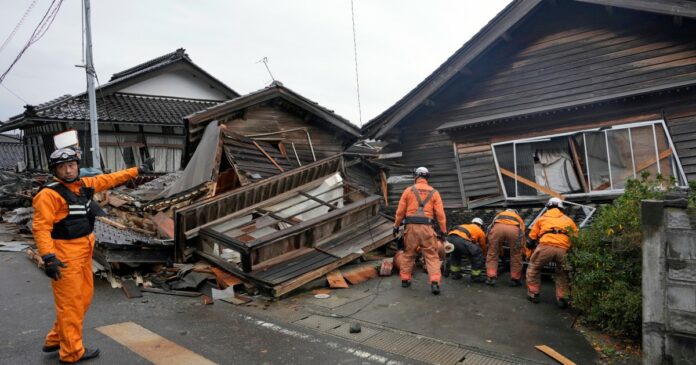Relief officials handed out water, blankets, food and other supplies. Search dogs joined military personnel and firefighters trying to find dozens of people who are thought to be trapped, although the exact number is unclear.
Weather forecasts warned of heavy rain in Ishikawa, leading to worries about landslides and further damage to half-crumbled homes. Temperatures were expected to drop to around 4 degrees Celsius (39 degrees Fahrenheit) overnight.
Of the deaths, 32 were counted in Wajima city, while 22 people died in Suzu, according to Ishikawa prefectural authorities. The other deaths were reported in five neighboring towns. Although there has been no official number of missing, dozens are believed trapped under collapsed buildings.
Kyodo News, with its own tally, said the deaths had risen to 73 because of more fatalities in Wajima.
More than 300 people have been injured, at least 25 of them seriously.
Ishikawa Gov. Hiroshi Hase encouraged everyone to use masks, antiseptic and soap to guard against the spread of infectious diseases as evacuees shelter together. Ensuring adequate water supplies and toilets for those who were displaced is a priority, he said.
Nearly 33,000 people are staying at evacuation centers, and some said they were hungry and cold, unable to sleep and afraid.
When Monday’s quake hit, Yasuo Kobatake ran out of his house with just one sock on. The shaking threw him to the ground, and a concrete wall came crashing down, barely missing him, he said.
He was eating only rice balls and a few sips of water in paper cups at the elementary school where he and others were sheltering. They slept on cushions, with no blankets.
“It was so cold. I thought I’d freeze to death,” he said.
In the aftermath of the quakes and tsunami, boats lay overturned in the sea, roads were blocked by mounds of dirt, and pillars and walls lay scattered from flattened homes. A large fire turned an entire section of Wajima city into ashes.
Officials warned that more major quakes could follow.
Japan is prone to earthquakes, with many fault lines and volcanoes. A massive quake, tsunami and nuclear disaster in 2011 caused widespread damage in northeastern Japan.
No major problems were reported at nuclear plants after Monday’s quake. The Shika nuclear plant in Ishikawa suffered a partial electricity failure, but backup power kicked in, ensuring the critical cooling process continued.
Japan is an organized, conformist and relatively crime-free society where warnings are systematically relayed as a public service. Disaster experts say that’s helping save lives.
Takako Izumi, a disaster science professor at Tohoku University, said time is needed to figure out logistics because roads are often blocked after an earthquake, and large trucks can’t get through to deliver aid.
If land routes aren’t accessible, aid may have to be dropped from the sky or brought in by boat. The winter cold adds to health risks, and some people may still have not reached an evacuation center, she added.
“We need to accurately assess the damage first. And then a proper response can come, and what’s needed can reach the right places,” Izumi said.


